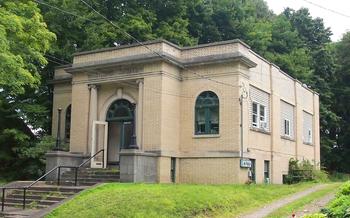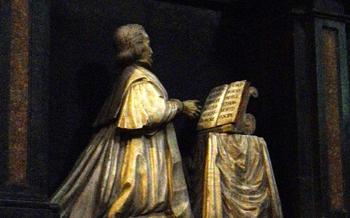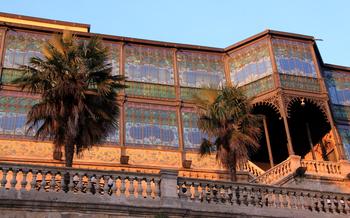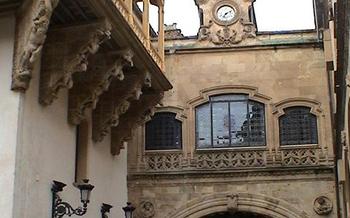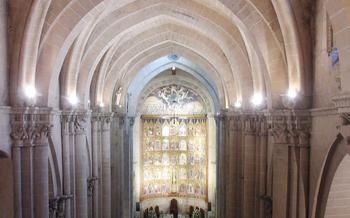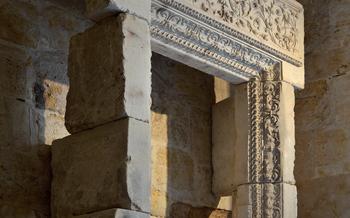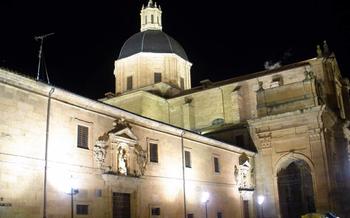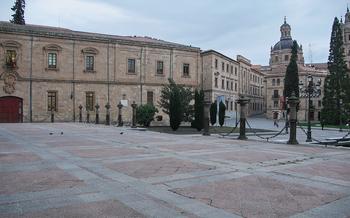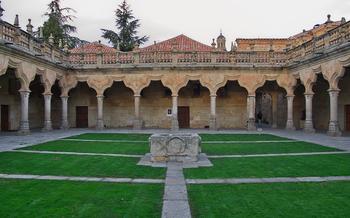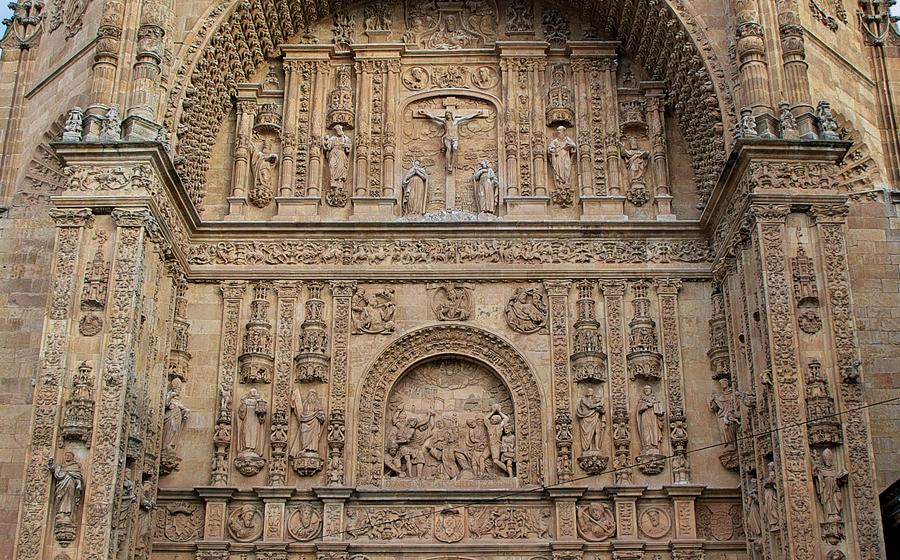
Convento de San Esteban
- Convento de San Esteban: A Gothic Masterpiece in Salamanca
- A Journey Through Time: The History of San Esteban
- Exploring the Architectural Marvel
- Must-See Highlights of the Convent
- Immerse in the Sacred Art
- A Walk Through the Cloisters
- Discover the Chapter House
- Unearthing the Secrets of the Sacristy
- A Glimpse into the Dominican Life
- Visiting Information: Plan Your Trip
- Unforgettable Experiences: Beyond the Convent Walls
- Capture the Essence: Photography Tips
- Respect and Etiquette: A Visitor's Guide
- Insider Tip: Unveiling the Secret Passage
Convento de San Esteban: A Gothic Masterpiece in Salamanca
A journey to Salamanca, a city brimming with architectural wonders, is incomplete without a visit to the Convento de San Esteban, a remarkable Gothic masterpiece that stands as a testament to the city's rich history and artistic heritage. Founded in the 13th century, the convent has undergone several expansions and renovations over the centuries, resulting in a harmonious blend of architectural styles, creating a captivating visual spectacle that draws visitors from around the world.
The exterior of San Esteban is an awe-inspiring sight, with its intricate carvings and delicate tracery adorning the facade, hinting at the treasures that lie within. Step inside, and you'll be transported back in time, surrounded by stunning Gothic arches, vaulted ceilings, and a serene atmosphere that invites contemplation and reflection.
A Journey Through Time: The History of San Esteban
Founded in the 13th century, the Convento de San Esteban holds a prominent place in the annals of Salamanca. Initially established as a modest hermitage by a group of Dominican friars, it underwent a remarkable transformation over the centuries, evolving into a sprawling complex that epitomizes Gothic architecture and Dominican spirituality.
During the 15th and 16th centuries, the convent experienced a period of immense growth and prosperity under the patronage of influential figures such as the Catholic Monarchs, Isabella I and Ferdinand II, and the Duke of Alba. This patronage enabled the construction of the convent's most iconic structures, including the Main Cloister, the Chapter House, and the Sacristy.
Throughout its history, the Convento de San Esteban played a pivotal role in religious, intellectual, and cultural life in Salamanca. It served as a center of theological studies, attracting renowned scholars and theologians from across Europe. The Dominican friars also played a crucial role in the development of the city's university, contributing to its reputation as a leading center of learning in the Middle Ages.
Despite facing challenges and periods of decline over the centuries, the Convento de San Esteban has managed to preserve its architectural splendor and spiritual significance. Today, it stands as a testament to the enduring legacy of the Dominican Order and the remarkable artistic and cultural heritage of Salamanca.
Exploring the Architectural Marvel
The Convento de San Esteban stands as an embodiment of Gothic grandeur, showcasing intricate carvings and sculptures that adorn its façade, cloisters, and interiors. Visitors are greeted by an awe-inspiring display of artistry upon entering the convent. The ribbed vaults and pointed arches create an ethereal atmosphere, while the elaborate retablos and statues add a touch of divinity.
The cloisters, with their serene ambiance, offer a glimpse into the peaceful life of the Dominican friars. Ornate arches and columns frame the tranquil gardens, creating a harmonious blend of nature and architecture. The symbolism and iconography depicted in the carvings and frescoes provide insights into the beliefs and values of the Dominican order.
One of the convent's unique features is the Chapter House, where the friars convened for important decisions and discussions. The architectural details, such as the intricate carvings and stained glass windows, reflect the significance of this space. Discover the intriguing stories and legends associated with the Chapter House, and learn about its current use as a venue for cultural events and exhibitions.
Must-See Highlights of the Convent
The Convento de San Esteban boasts several must-see highlights that captivate visitors with their artistic and historical significance.
-
The Main Altarpiece: This awe-inspiring altarpiece, crafted in the 16th century, is a masterpiece of Gothic art. Its intricate carvings, vibrant colors, and lifelike figures depict scenes from the life of Christ and the Virgin Mary.
-
The Chapel of the New Kings: Dedicated to the Catholic Monarchs, Ferdinand and Isabella, this chapel is a testament to the Dominican order's close ties with the Spanish monarchy. Its stunning frescoes, delicate tracery, and intricate carvings create an atmosphere of grandeur and reverence.
-
The Sacristy: A treasure-trove of sacred objects, the sacristy houses an impressive collection of goldsmithing, exquisite vestments, and liturgical artifacts. Its ornate furnishings, intricate carvings, and stained-glass windows add to its sacred ambiance.
-
The Library: A haven for scholars and book lovers, the library boasts a vast collection of ancient manuscripts, rare books, and valuable documents. Its impressive architecture, featuring vaulted ceilings, intricate carvings, and stained-glass windows, creates a conducive environment for study and contemplation.
Immerse in the Sacred Art
The Convento de San Esteban houses a treasure trove of sacred art that will captivate the eyes and hearts of visitors. Notable paintings adorn the walls of the church and chapels, showcasing the artistic talent of renowned masters. Exquisite sculptures, carved with meticulous precision, depict biblical figures and scenes, breathing life into the stories of faith. Stained glass windows bathe the interior in a kaleidoscope of colors, casting a mystical glow upon the sacred space. The artistic significance of these masterpieces is undeniable, as they not only enhance the beauty of the convent but also provide a profound connection to the spiritual realm.
A Walk Through the Cloisters
The cloisters of the Convento de San Esteban are an architectural masterpiece, offering a serene and awe-inspiring space for contemplation and reflection. As you step inside, you'll be greeted by a tranquil atmosphere, enhanced by the rhythmic arches and graceful columns that surround the courtyard.
Admire the intricate carvings and sculptures that adorn the cloisters, each one telling a unique story from the Bible or the life of Saint Dominic. Pay attention to the symbolism and iconography embedded in the designs, as they hold profound spiritual and historical significance.
Take a moment to stroll through the gardens, where vibrant flowers and aromatic plants create a sensory haven. The tranquil sounds of birdsong and the gentle breeze rustling through the leaves add to the peaceful ambiance of the cloisters, making it an ideal place to find inner peace and tranquility.
Discover the Chapter House
Amidst the grand halls and cloisters of the Convento de San Esteban, the Chapter House stands as a testament to the monastery's rich history and enduring legacy. This sacred space served as a gathering place for the Dominican friars, where they convened to discuss matters of faith, governance, and community.
Step into the Chapter House, and you'll be transported back in time. The room's architectural details are a testament to the skill and artistry of the medieval builders. Intricate carvings adorn the walls, depicting scenes from the Bible and the lives of the saints. The vaulted ceiling, supported by elegant columns, creates a sense of awe and reverence.
As you explore the Chapter House, imagine the friars gathered here, their voices echoing through the chamber as they debated theological questions, made important decisions, and planned their charitable works. The atmosphere is palpable, a reminder of the profound impact the Dominican Order has had on the religious and intellectual life of Salamanca.
Today, the Chapter House serves as a multifunctional space, hosting exhibitions, concerts, and other cultural events. Its transformation from a place of solemn deliberation to a vibrant venue for contemporary expression reflects the adaptability and enduring relevance of the Convento de San Esteban.
Unearthing the Secrets of the Sacristy
Venturing into the sacristy of the Convento de San Esteban is like stepping into a treasure trove of sacred objects. This hallowed space, reserved for the preparation of liturgical ceremonies, houses an exquisite collection of goldsmithing, religious artifacts, and vestments that testify to the devotion and artistry of past generations.
Marvel at the intricate gold and silver chalices, monstrances, and reliquaries, each adorned with precious stones and delicate filigree. The craftsmanship is simply breathtaking, showcasing the exceptional skills of the goldsmiths who created these masterpieces.
Discover the profound liturgical significance of the objects housed in the sacristy. From ornate processional crosses to elaborate censers, each item played a vital role in the religious ceremonies and rituals performed within the convent.
Delve deeper into the stories behind these sacred artifacts. Uncover the tales of their creation, the donors who commissioned them, and the events they were used in. These objects were not mere decorations but tangible expressions of faith and devotion.
The sacristy of the Convento de San Esteban is a place of wonder and reverence, where the spiritual and the artistic intertwine. It invites visitors to contemplate the profound significance of these sacred objects and gain a deeper appreciation for the Dominican order's rich history and traditions.
A Glimpse into the Dominican Life
The Convento de San Esteban was not just a place of worship; it was also a hub of Dominican life. The friars who lived here followed a strict routine of prayer, study, and service. They rose early for morning prayers and then spent the day studying theology, philosophy, and the arts. They also dedicated themselves to helping the poor and sick, providing education to the local community, and working as missionaries in far-off lands.
The Dominicans played a significant role in the intellectual and cultural life of Salamanca. They founded the University of Salamanca, one of the oldest and most prestigious universities in Europe. They also established a renowned library, which contains a vast collection of manuscripts, books, and incunabula. The Dominicans' commitment to education and scholarship helped to make Salamanca a center of learning and culture during the Middle Ages and Renaissance.
The Dominican friars also left a lasting legacy on the city of Salamanca. They were responsible for building many of the city's most iconic landmarks, including the Convento de San Esteban, the University of Salamanca, and the Catedral Vieja. They also played a key role in the city's political and social development. The Dominicans' influence can still be seen in Salamanca today, and their spirit continues to inspire the city's people.
Visiting Information: Plan Your Trip
The Convento de San Esteban is conveniently located within the historic center of Salamanca, making it easy to incorporate into your sightseeing itinerary. Plan your visit during the convent's opening hours, typically from 9:30 AM to 1:00 PM and 4:00 PM to 6:00 PM daily. Admission fees are modest, providing excellent value for the wealth of history and beauty you'll encounter.
Enhance your experience by booking a guided tour, available in various languages. These tours offer insightful commentary, providing a deeper understanding of the convent's history, architecture, and artistic treasures. Alternatively, explore the convent independently, allowing you to set your own pace and focus on the aspects that most captivate you.
To fully appreciate the convent's grandeur, consider visiting during the summer months when the longer daylight hours allow for more leisurely exploration. However, the convent's serene atmosphere and intricate details are equally captivating during the off-season, offering a more intimate and reflective experience.
Whether you opt for a guided tour or self-exploration, ensure you allocate ample time to appreciate the convent's many wonders. Plan to spend at least two hours immersing yourself in its history and beauty, ensuring you don't miss any of its captivating highlights.
Unforgettable Experiences: Beyond the Convent Walls
A visit to the Convento de San Esteban is just the beginning of your journey in Salamanca. Step outside the convent's walls and immerse yourself in the vibrant city that surrounds it. Explore the historic center, a UNESCO World Heritage Site, and admire its stunning architecture, including the iconic Plaza Mayor and the University of Salamanca.
Indulge in the local cuisine, savoring traditional dishes like cochinillo asado (roast suckling pig) and hornazo (a savory pastry filled with pork, sausage, and eggs). Attend cultural events, such as concerts, exhibitions, and festivals, that showcase Salamanca's rich cultural heritage. Discover hidden gems like the Huerto de Calixto y Melibea, a beautiful garden that inspired the famous love story "La Celestina."
With its captivating history, stunning architecture, and vibrant atmosphere, Salamanca offers an unforgettable experience for every traveler. Embrace the city's charm and create memories that will last a lifetime.
Capture the Essence: Photography Tips
The Convento de San Esteban is a photographer's paradise, with its intricate details, stunning architecture, and serene atmosphere. To capture the essence of this Gothic masterpiece, consider these photography tips:
-
Ideal Lighting Conditions: Aim for golden hour, either in the morning or evening, when the warm light casts a magical glow on the convent's facade and interiors.
-
Composition and Angles: Experiment with different angles and perspectives to create dynamic compositions. Capture the grandeur of the building from a low angle, or focus on specific architectural elements for close-up shots.
-
Capturing the Details: Pay attention to the intricate carvings, sculptures, and stained glass windows that adorn the convent. Zoom in to capture the artistry and symbolism hidden within these details.
-
Sharing Your Memories: Share your beautiful photographs with friends, family, and fellow travelers on social media or your personal blog. Use hashtags like #ConventodeSanEsteban, #Salamanca, and #GothicArchitecture to connect with other photography enthusiasts.
Respect and Etiquette: A Visitor's Guide
As you step into the sacred grounds of the Convento de San Esteban, it is essential to show respect for the religious significance of the site and the Dominican community that resides within. Dress modestly and appropriately, avoiding revealing or casual attire. Maintain silence and reverence while exploring the convent, respecting the peaceful atmosphere and the ongoing religious activities.
Photography is permitted, but be mindful of the restrictions and guidelines. Refrain from using flash or intrusive equipment that may disrupt the serenity of the space. Above all, practice responsible tourism, leaving no trace of your visit and respecting the delicate balance of this historic treasure.
Insider Tip: Unveiling the Secret Passage
Beyond the visible wonders of the Convento de San Esteban lies a hidden gem that few visitors know about—a secret passage that leads to a network of underground tunnels. These tunnels were once used by the Dominican friars for various purposes, including transporting goods and accessing different parts of the convent without disturbing the public.
To discover this hidden passage, look for an unassuming door near the sacristy. Once you step through the door, you'll find yourself in a narrow, dimly lit corridor that leads to the tunnels. As you explore these subterranean passages, you'll gain a deeper understanding of the convent's history and the daily lives of the Dominican friars.
The secret passage offers a unique perspective on the convent, allowing you to uncover its hidden secrets and unravel its intriguing stories. It's a must-see for anyone who wants to experience the Convento de San Esteban beyond the main tourist attractions.
